Text
When he was dragged into municipal court, demanding the judge legalize marijuana and LSD, he was committed as an emergency case to the county hospital psychiatric ward.
In his admittance report, a physician noted, “The patient states that he has been hospitalized... with a diagnosis of chronic undifferentiated schizophrenia, which the patient describes as: 'Don't know if I want to make love with a man, don't know if I want to make love with a woman, don't know if I want to make love with myself...’”
The doctor agreed with the earlier diagnoses.
(Excerpt from "The Die Song" by Donald Lunde)
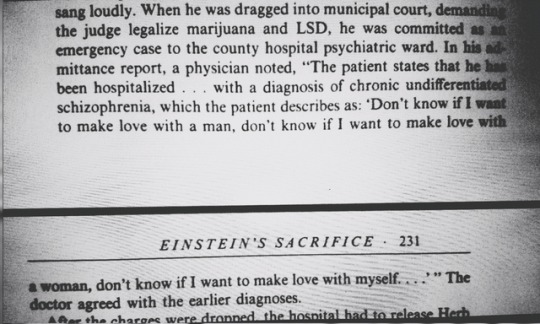

#herbert mullin#herb mullin#mullin#the die song#donald t lunde#donald lunde#psychology#santa cruz#california#serial killers#serial killer#schizophrenia#paranoid#bisexual#bisexuality#1973#crime#crimes#true crime#tcc#true crime community#murder#murderer#mule creek#mule creek prison#miep#miep knipperdolling#herbert william mullin#herbert wm mullin#herbie
18 notes
·
View notes
Photo

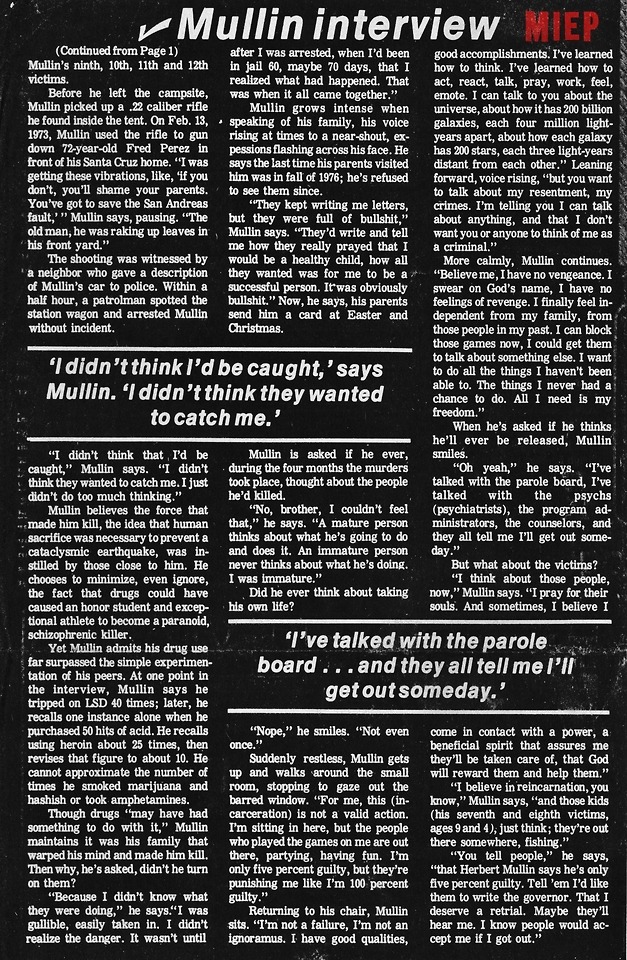
(July 8, 1981)
#Herbert Mullin#Herb Mullin#Herbie Mullin#Herbert William Mullin#Santa Cruz#california#serial killers#Serial Killer#mullin#miep#interview#1981#true crime research#true crime#crime
17 notes
·
View notes
Photo

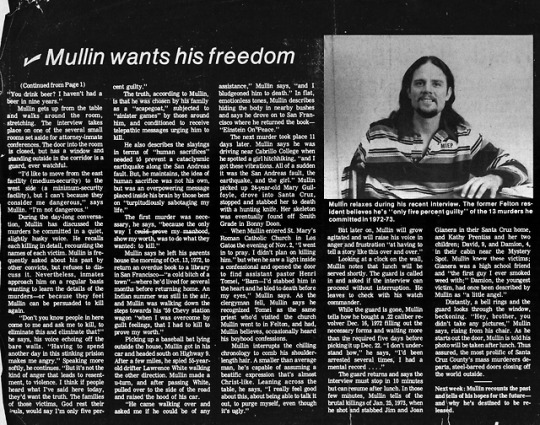
(July 1, 1981)
#herbert mullin#herb mullin#herbert william mullin#herbie mullin#1981#interview#santa cruz#california#serial killers#serial killer#mullin#miep#true crime research#true crime#crime
34 notes
·
View notes
Photo
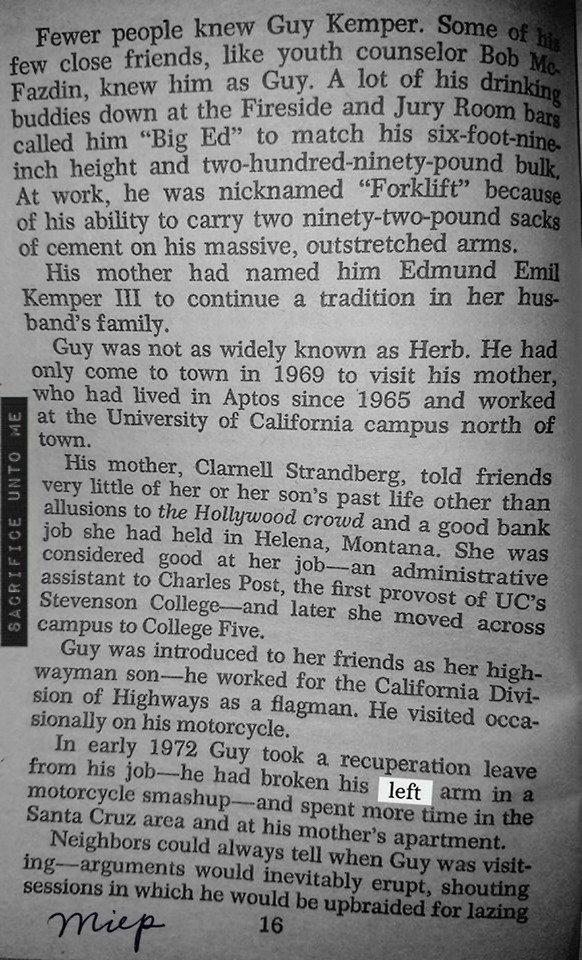


Fewer people knew Guy Kemper. Some of his few close friends, like youth counselor Bob Fazdin, knew him as Guy. A lot of his buddies down at the Fireside and Jury Room called him "Big Ed" to match his six-foot-inch height and two-hundred-ninety-pound bulk. At work, he was nicknamed "Forklift" because of his ability to carry two ninety-two-pound sacks of cement on his massive, outstretched arms.
His mother had named him Edmund Emil Kemper III to continue a tradition in her husband's family.
Guy was not as widely known as Herb (Mullin). He had only come to town in 1969 to visit his mother, who had lived in Aptos since 1965 and worked at the University of California campus north of town.
His mother, Clarnell Strandberg, told friends very little of her or her son's past life other than allusions to the Hollywood crowd and a good bank job she had held in Helena, Montana. She was considered good at her job — an administrative assistant to Charles Post, the first provost of UC's Stevenson College — and later she moved across campus to College Five.
Guy was introduced to her friends as her highwayman son — he worked for the California Division of Highways as a flagman. He visited occasionally on his motorcycle.
In early 1972 Guy took a recuperation leave from his job — he had broken his left arm in a motorcycle smashup — and spent more time in Santa Cruz area and at his mother's apartment.
Neighbors could always tell when Guy was visiting — arguments would inevitably erupt, shouting sessions in which he would be upbraided for lazing about drinking beer and not making something himself.
Mrs. Strandberg was a large woman, standing exactly six feet tall and built as square as her son. Her voice was heavy and when angry carried a long distance. She had been known to reduce Guy to tears in front of his friends with her sharp tongue.
He took to spending more time drinking at the Jury Room bar, where the town policemen, sheriff's deputies and staff members from the district attorney's office did their relaxing.
Guy's extraordinary feats of strength and his drinking prowess soon became the subject of friendly wagers among patrons. And Guy confided that if he had had his way, he would have been on the police force. His enormous height had made this impossible, though.
He liked to discuss guns with off-duty officers, comparing notes on the relative effectiveness of hollow-point versus solid-core bullets; whether a magnum weapon was really worth the extra money; whether a Smith and Wesson was better than any other brand. He explained his interest in and knowledge of guns with a story of being a part-time security guard in Alameda County where he had an apartment.
After he wrecked his motorcycle, Guy drove an old yellow Ford and immediately crumpled the right rear fender, requiring a makeshift tail light on that side.
The easily recognizable two-door sedan came and went at all hours. And the mother and son arguments raged as often and irregularly.
He once explained to a neighbor girl, twenty-year-old Carla Gervasoni, that the arguments between him and his mother were just the way they expressed themselves as a family.
"We like to get things out in the open. My mother and are really very close and we know these fights don't mean anything," Guy said, apologizing for the late hour at which the last argument had erupted.
He appeared thoughtful of his mother in many ways, remembering her with gifts on special occasions like Easter and her birthday.
Only once did Guy ever bring a girl around to meet his mother, a young blonde who was dwarfed by his enormity. He introduced her as his fiancée.
Down at The Jury Room, he mentioned only that he had met a girl he might marry because she was not smarter than he was.
"I sure couldn't stand a woman smarter than me," he said.
Edmund Emil Kemper Ill was just one of the guys.
(Excerpt from: “Sacrifice Unto Me” by Don West)
#Edmund Kemper#Ed Kemper#Edmund Emil Kemper III#Edmund Emil Kemper#sacrifice unto me#don west#the jury room#jury room#guy kemper#kemper#engagement#engaged#fianceé#fiance#the co-ed killer#the coed killer#Co-ed Killer#Coed Killer#crime#santa cruz#california#Clarnell Strandberg#Clarnell Kemper#serial killers#serial killer#true crime#tcc#murder#guns#miep
68 notes
·
View notes
Text

***I am unsure of the veracity of these claims - it is not corroborated by other sources on the subject***
"[Edmund] Kemper was driven by manic sex urges but saddled with a crippling sense of inferiority. He had a small penis, which on him looked minuscule, and was quite inept as a lover. The one woman who had accepted him refused a second date. Convinced that no living female would bear him, Kemper's cravings gave fuel to his simmering rage against his mother, who in simultaneously protecting, brow-beating, and disciplining him had made him feel "small as a mouse."
(Excerpt from: "Murder U.S.A." by John Godwin)
#edmund kemper#ed kemper#edmund emil kemper iii#edmund emil kemper#co-ed killer#coed killer#california#santa cruz#kemper#miep#serial killer#serial killers#the co-ed killer#the coed killer#crime#true crime#coedkiller#murder#tcc#big ed#murderer#true crume#true crime research#fragile masculinity
91 notes
·
View notes
Photo
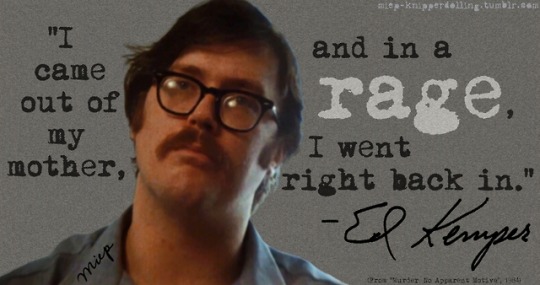
#rage#Ed Kemper#Edmund Kemper#Edmund Emil Kemper III#Edmund Emil Kemper#the co-ed killer#the coed killer#Coed Killer#Co-ed Killer#kemper#serial killer#serial killers#quote#quotes#Ed Kemper Quotes#ed kemper quote#Edmund Kemper Quotes#Edmund Kemper quote#big ed#santa cruz#california#true crime#crime#murder#Clarnell Strandberg#Clarnell Kemper#matricide#psychology#deep thoughts#miep
78 notes
·
View notes
Photo

An excerpt from a newspaper article written during his 1973 trial (dated: October 26, 1973) - that gives some insight into Edmund Kemper's state of mind.
"I remember it was very exciting... there was actually a sexual thrill... it was a kind of an exalted triumphant type thing, like taking the head of a deer or an elk or something would be to a hunter. "
"I was the hunter and they were my victims."
Kemper also talked about his outward characteristics that enabled him to move through the community, killing without attracting suspicion. He said tie had once fantasized about killing everyone on the block around his mother's apartment on Ord St. in Seacliff.
"...Considering the abilities I did have in say, creating a calm about me where people weren't excited or suspicious or nervous and had the trust of most people around me, I believed and I still believe that had I wanted to, just as a demonstration... and I thought of making this as a demonstration to the authorities in Santa Cruz, how serious this was and how bad a foe they had come up against."
"I had thought of annihilating the entire block I lived on ... and the houses opposing it, which would have included as many as 20 or 12 families... I would have done it and left, I think very unnoticeably by the other people that would still be there."
When Kemper was arrested in Colorado, authorities said he had two rifles, one with a telescopic lens and a shotgun and over 200 rounds of ammunition in his car. Kemper explained in the taped interview why he had the guns.
"I did intend when I took those weapons with me, not to hide in the corner and defend myself, but I had planned to make a last great outburst; but towards the end there I started seeing the folly of the whole damn thing and at the point of near exhaustion, near collapse, I just said to hell with it and called it all off."
"I couldn't worry so much about myself getting killed or hurt, I just didn't want to see anybody else to get hurt or killed trying to stop me from what I had been doing."
Kemper said that before his surrender he was exhausted from his drive across country to Colorado, in what he thought was a flight from police who surely would have discovered his mother's murder. He left her body and that of her best friend in closets in his mother's apartment.
He said it came as a shock to him when he learned in his surrender call Co the Santa Cruz police from a phone booth in Pueblo that the murders had not yet been discovered.
He was asked by Sgt. Michael Aluffi what his ultimate purpose was in surrendering and telling his complete story.
Kemper replied, "Well, there again, it's only mostly a complete story. Like I said, there are some things I'm sure are of interest to certain people, maybe everybody... but my main purpose is getting it off my chest because whatever's on my chest must stay I'm sure..."
But let's say I have some accounts payable and I have closed my accounts receivable, and so I have balanced the accounts.
"I guess I could, be facetious about it and, say 'Well, I gave you guys a year to catch up with me,' and I mean, s- - I could have kept going forever, which is facetious; I really couldn't have."
"Emotionally, I couldn't handle it much longer, so considering, I don't know who would consider me lucky I didn't get caught, there are times I wish I had been caught. But considering that I wasn't, there was a certain consideration that police weren't going to do something. I had to do something."
"I'm sure they were trying, but with the tools, police have to work with and with the basic concept that society isn't as cold-blooded as ruthless and back-stabbing as I am... if I had kept my mouth shut I would have gotten away with them."
#Edmund Kemper#Ed Kemper#Edmund Emil Kemper III#Edmund Emil Kemper#the co-ed killer#the coed killer#Co-ed Killer#Coed Killer#santa cruz#california#newspaper#1973#kemper#crime#serial killers#serial killer#true crime#tcc#pschology
64 notes
·
View notes
Photo
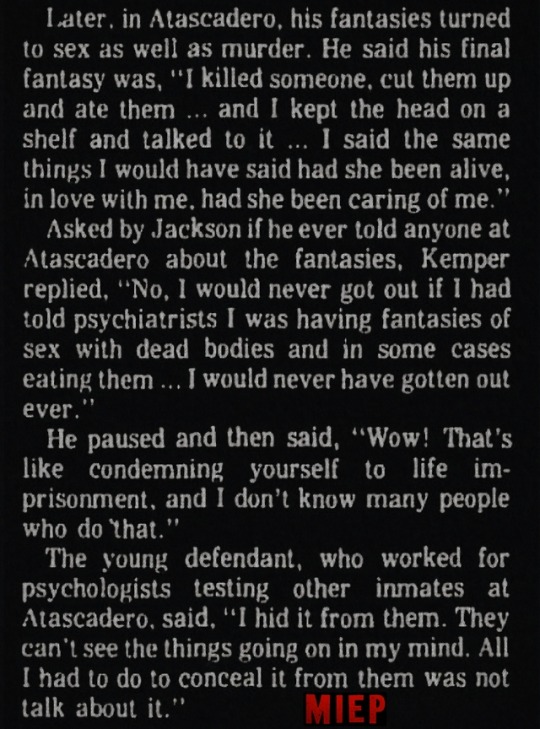
#Edmund Kemper#Ed Kemper#Edmund Emil Kemper III#Edmund Emil Kemper#the co-ed killer#the coed killer#Co-ed Killer#Coed Killer#serial killers#serial killer#Atascadero#fantasy#fantasies#True Crime#crime#true crime research#kemper#miep#court#1973#santa cruz#california#Newspaper#tcc
26 notes
·
View notes
Photo

"I was raging inside, there was just incredible energies ...positive and negative… depending on a mood, that would trigger one or the other. And outside, I looked troubled at times, other times, I looked moody. Uh, other times, perfectly serene. Not very sane. But again… people weren’t even aware of what was happening." - Edmund Kemper (from the interview in “Murder: No Apparent Motive”, 1984)
#Edmund Kemper#Ed Kemper#Edmund Emil Kemper III#Edmund Emil Kemper#the co-ed killer#the coed killer#Ed Kemper Quotes#ed kemper quote#Edmund Kemper Quotes#Edmund Kemper quote#serial killers#serial killer#serial killer quotes#true crime#true crime research#tcc#Santa Cruz#california#Murder no apparent motive#1984#miep#kemper#Coed Killer#Co-ed Killer#Vacaville
27 notes
·
View notes
Photo

Ray Kemper (Edmund Kemper's uncle - his father's younger brother) was an influential sound effects artist throughout the 50's, 60's, and 70's. He worked on a ton of radio and TV shows - most notably, Gunsmoke.
• Excerpt from "Tales of a Happy Kemper":
In January of 1942, Ray Kemper had just graduated from high school. The whole country was still reeling from the shock of Pearl Harbor, and the West Coast felt particularly vulnerable to possible Japanese attack. But for Ray -- in spite of his "1-A" draft status with Uncle Sam -- life was full of promise. He was working in radio at KHJ in Hollywood!
It was difficult to grow up in the shadow of Tinsel Town without dreams of an acting career, and Ray was no exception. In high school, he joined a little theater group and landed the lead role of Henry Aldrich in Clifford Goldsmith's hit play What A Life! Another twist of fate had opened the doors to acting parts in radio shows.
Ray came from a modest, middle-class family with an older brother who had volunteered for military service in 1938 and who was already overseas doing combat duty. A friend of the family who worked in radio knew Celeste Rush, the wife of Lou Merrill, a very busy, very good radio actor in Hollywood for many years. Celeste, a handsome woman with raven black hair, had at one time done some radio acting herself. Currently, however, she conducted the Celeste Rush School of Radio Acting. The family friend contacted Celeste on behalf of the eager teenager, and Celeste invited Ray Kemper for an interview. This resulted not only in his acceptance but carried a scholarship so that Ray's tuition would be only $10 a month, a fraction of the usual rate. Ray explained that his parents were "anything but wealthy," so his after-school job at a grocery store paid the modest fee.
In 1948 an "executive" (who shall be nameless) lured Ray Kemper away from radio to a position as writer/director for a major ad agency in Hollywood. He soon found that the main criterion for a good ad man was to be a first class "huckster." After suffering in that job for two years Ray resigned and returned to what he perceived to be his "first love" -- acting. He did a few radio shows and appeared in one movie, Navy Bound with Tom Neal. However, Ray explained that because he and his family had become accustomed to eating regularly he accepted a position in the CBS Radio (Hollywood) sound effects department when it became available in March 1951, and for the next seven years did sound effects with such programs as The Jack Benny Show, Gunsmoke, Suspense, Escape, Fort Laramie, Have Gun, Will Travel, The Whistler, Romance, Amos 'n Andy, and many others. During this period he continued his writing career, selling scripts to Gunsmoke and Have Gun, Will Travel.
During the next twenty years, Ray Kemper was responsible for the audio on such shows as the Red Skelton Comedy Hour, The Glen Campbell Goodtime Hour, The Jeffersons, Maude, Three's Company, The Carol Burnett Show, The Smothers Brothers' Comedy Hour, One Day at a Time and many more. He also rode herd over CBS specials including Death of a Salesman, The Ann Margaret Show, Brigadoon, and showcases which featured Diana Ross, Dean Martin, and Danny Thomas. In 1967 he was nominated for an Emmy Award for his sound engineering on the musical Brigadoon.
Deciding that he'd had enough of the "craziness of Hollywood," Ray Kemper retired in 1980. He and wife Novice built a home in the Sierra Nevada mountains, 45 miles northeast of Fresno, where they now live. They have two daughters, three grandchildren and three great-grandchildren.
He has resisted all temptations to return to "the business" except one:
"In 1991 I was asked to fly back to New Jersey to write and direct a recreation of a Gunsmoke show. I couldn't resist that one and accepted. Afterward, they presented me with an award honoring me for my contributions to the golden age of radio. Although very flattered -- I also found myself laughing because I knew something they didn't. I knew that deep down inside I was still the same skinny, shy, red-headed kid I had always been."
°°°°°°°°°°°°°°°°°°°°°°°°°°°°°°°°°°°°°°°°°°°°°°°°°°°°°°°°°°
More Info:
▪ Tales of a Happy Kemper by Walter J. Beaupre (From Interviews With Ray Kemper)
▪ Audio Interview with Ray Kemper (date: unknown)
▪ Sound Effects by Dan Haefele
▪ Interview with Ray Kemper about sound effects for Voyage of the Scarlet Queen (1991)
▪ Interview with Ray Kemper about sound effects on Gunsmoke
▪ Ray Kemper's IMDB
#Ray Kemper#Edmund Kemper#Ed Kemper#Edmund Emil Kemper III#Edmund Emil Kemper#the co-ed killer#the coed killer#Co-ed Killer#Coed Killer#serial killer#serial killers#california#family#miep
19 notes
·
View notes
Photo

(Excerpt from” “Urge to Kill” by Ward Damio)
#Edmund Kemper#Ed Kemper#Edmund Emil Kemper III#Edmund Emil Kemper#the co-ed killer#the coed killer#Co-ed Killer#Coed Killer#serial killers#serial killer#true crime research#true crime#crime scene#Santa Cruz#california#fantasy#fantasies#Big Ed#psychology#hitchhiking#pete chang#trial#cannibal#cannibalism#psychopath#kemper#miep
36 notes
·
View notes
Photo

“I never hit her. I killed her… but I didn’t hit her.” - Edmund Kemper
#ed kemper#edmund kemper#coed killer#edmund emil kemper iii#edmund emil kemper#quotes#ed kemper quotes#edmund kemper quotes
28 notes
·
View notes
Photo

(Map of the Santa Cruz area from “Sacrifice Unto Me” - with the locations of the crimes committed by Herbert Mullin & Edmund Kemper)
#Edmund Kemper#Herbert Mullin#Ed Kemper#Herb Mullin#Edmund Emil Kemper III#Edmund Emil Kemper#Herbert William Mullin#guy kemper#herbie mullin#miep#kemper#mullin#serial killers#serial killer#true crime research#true crime#santa cruz#california#map#Sacrifice Unto Me#Don West#alice lin#Mary Guilfoyle#Rosalind Thorpe#Fred Perez#Cynthia Schall#Henri Tomei#Lawrence White#aiko koo#Mary Ann Pesce
19 notes
·
View notes
Photo

(Map of the San Francisco area from “Sacrifice Unto Me” - with the locations of the crimes committed by Herbert Mullin & Edmund Kemper)
#Herbert Mullin#Edmund Kemper#Ed Kemper#Herb Mullin#Herbie Mullin#Herbert William Mullin#Edmund Emil Kemper III#Edmund Emil Kemper#the co-ed killer#the coed killer#Coed Killer#Co-ed Killer#1972#1973#san francisco#Santa Cruz#california#miep#Guy Kemper#Kemper#true crime research#True Crime#map#alameda#Mary Ann Pesce#Anita Luchessa#Alice Liu#Rosalind Thorpe#Aiko Koo#Henri tomei
9 notes
·
View notes
Photo

#Ed Kemper#Edmund Kemper#Edmund Emil Kemper III#Edmund Emil Kemper#the coed killer#the co-ed killer#Coed Killer#Co-ed Killer#crime#Cannibal#cannibalism#true crime#true crime research#miep#kemper#serial killers#serial killer#tcc#Joel Fort#sodium ambutol#psychiatry#court#1973#Santa Cruz#Newspaper#california
37 notes
·
View notes
Photo
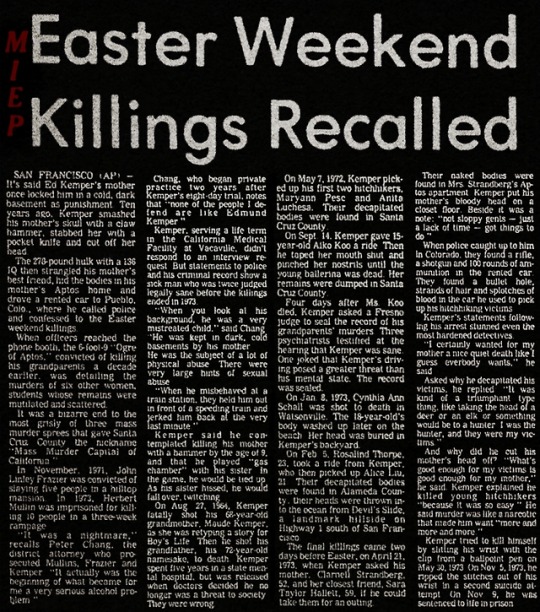
It's said Ed Kemper's mother once locked him in a cold, dark basement as punishment. Ten years ago, Kemper smashed his mother's skull with a claw hammer, stabbed her with a pocket knife and cut off her head.
The 278-pound hulk with a 136 IQ then strangled his mother's best friend, hid the bodies in his mother's Aptos home and drove a rented car to Pueblo. Colorado, where he called the police and confessed to the Easter weekend killings.
When officers reached the phone booth, the 6 foot 9 inch “Ogre of Aptos." convicted of killing his grandparents a decade earlier was detailing the murders of six other women students whose remains were mutilated and scattered.
It was a bizarre end to the most grisly of three mass murder sprees that gave Santa Cruz County the nickname “Mass Murder Capital of California".
In November 1971, John Linley Frazier was convicted of slaying five people in a hilltop mansion. In 1973, Herbert Mullin was imprisoned for killing 10 people In a three-week rampage.
"It was a nightmare,” recalls Peter Chang, the district attorney who prosecuted Mullin, Frazier, and Kemper. “It actually was the beginning of what became for me a very serious alcohol problem.”
Chang, who began private practice two years after Kemper's eight-day trial, notes that “none of the people I defend are like Edmund Kemper."
Kemper, serving a life term the California Medical Facility at Vacaville, didn't Mispond to an interview request. But statements to police and his criminal record show a sick man who was twice judged legally sane before the killings ended in 1973.
When you look at his background, he was a very mistreated child." said Chang “He was kept in dark, cold treatment by his mother. He was the subject of a lot of physical abuse There were very large hints of sexual abuse.”
“When he misbehaved at a train station, they held him out In front of a speeding train and jerked him back at the very last minute."
Kemper said he contemplated killing his mother with a hammer by the age of 9, and that he played "gas chamber" with his sister. In the game, he would be tied up, as his sister hissed, he would fall over, twitching.
On Aug 27, 1964, Kemper fatally shot his 68-year-old grandmother Maude Kemper, as she was retyping a story for Boy's Life. Then he shot his grandfather, his 72-year-old namesake, to death. Kemper spent five years m a state mental hospital, but was released when doctors decided he no longer was a threat to society. They were wrong.
On May 7, 1972, Kemper picked up his first two hitchhikers, Mary ann Pesce and Anita Luchessa. Their decapitated bodies were found in Santa Cruz County.
On Sept 14, Kemper gave 15-year-old Alko Koo a ride. Then he taped her mouth shut and pinched her nostrils until the young ballerina was dead. Her remains were dumped in Santa Cruz County. Four days after Ms. Koo died, Kemper asked a Fresno judge to seal the record of his grandparents' murders. Three psychiatrists testified at the hearing that Kemper was sane. One joked that Kemper's driving posed a greater threat than his mental state. The record was sealed.
On Jan 8. 1973, Cynthia Ann Schall was shot to death In Watsonville. The 18-year-old's body washed up later on the beach. Her head was buried in Kemper's backyard.
On Feb 5, Rosalind Thorpe, 23, took a ride from Kemper, who then picked up Alice Liu, 21. Their decapitated bodies were found in Alameda County, their heads were thrown into the ocean from Devil's Slide, a landmark hillside on Highway 1 south of San Francisco.
The final killings came two days before Easter, on April 21, 1973, when Kemper asked his mother, Clarnell Strandberg, 52, and her closest friend, Sara Taylor Hallett, 59, if he could take them for an outing.
Their naked bodies were found in Mrs. Strandberg's Aptos apartment. Kemper put his mother's bloody head on a closet floor. Beside it was a note: "not sloppy gents - just a lack of time - got things to do."
When police caught up to him in Colorado, they found a rifle, a shotgun and 100 rounds ammunition in the rented car. They found a bullet hole, strands of hair and splotches of blood in the car he used to pick up his hitchhiking victims.
Kemper's statements following his arrest stunned even the most hardened detectives.
"I certainly wanted for my mother a nice quiet death like I guess everybody wants," he said.
Asked why he decapitated his victims, he replied "It was kind of a triumphant type thing, like taking the head of a deer or an elk or something would be to a hunter. I was the hunter, and they were my victims."
And why did he cut his mother's head off? "What's good enough for my victims Is enough for my mother," he said. Kemper explained he killed young hitchhikers "because It was so easy." He said murder was like a narcotic that made turn want "more and more and more."
Kemper tried to kill himself by slitting his wrist with the clip from a ballpoint pen on May 10,1973. On Nov 5. 1973, he ripped the stitches out of his wrist in a second suicide attempt. On Nov 9, he was sentenced to life in prison.
#Edmund Kemper#Ed Kemper#Edmund Emil Kemper III#Edmund Emil Kemper#the co-ed killer#the coed killer#Coed Killer#Co-ed Killer#kemper#newspaper#santa cruz#california#pete chang#peter chang#1983#miep#true crime#crime#true crime research#tcc#serial killers#serial killer#Cynthia Schall#john linley frazier#Herb Mullin#Herbert Mullin#Clarnell Strandberg#Clarnell Kemper#aptos#Maude Kemper
36 notes
·
View notes
Photo
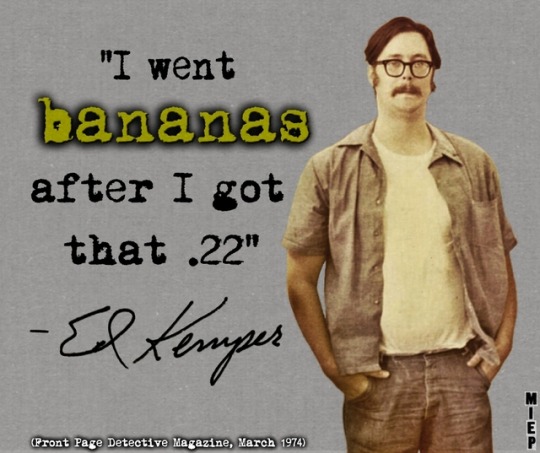
“I went bananas after I got that .22” - Edmund Kemper
(Front Page Detective Magazine March 1974 by Marj von Beroldingen)
#ed kemper#edmund kemper#edmund emil kemper iii#edmund emil kemper#co-ed killer#coed killer#coedkiller#front page detective#1974#santa cruz#ed kemper quotes#edmund kemper quotes
17 notes
·
View notes